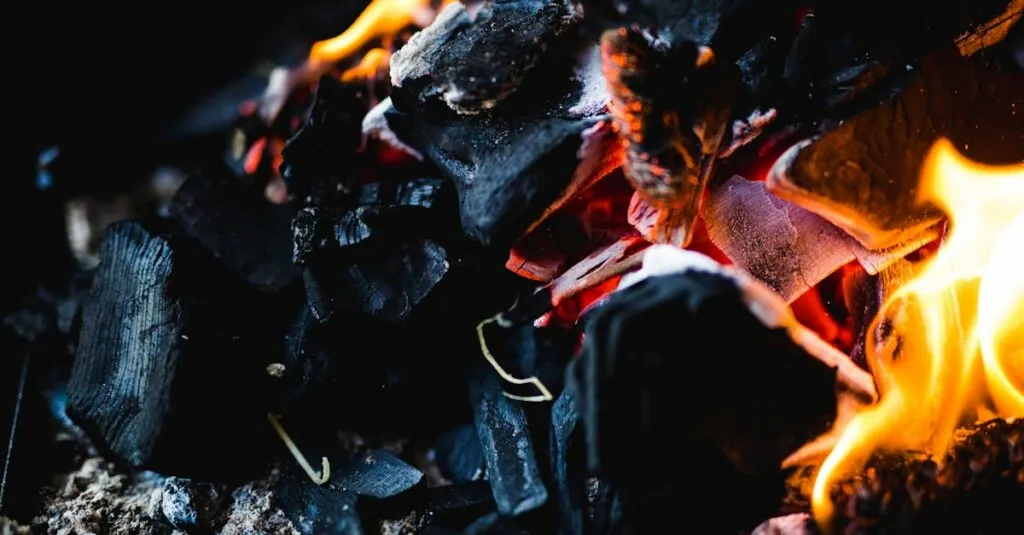Table of Contents
TogglePicture this: a cozy evening under the stars, the crackle of wood, and the warmth of a fire pit bringing friends and family together. Sounds perfect, right? But before diving headfirst into the flames, he or she needs to know a few essential fire pit installation tips. After all, no one wants their backyard to turn into a scene from a disaster movie.
Essential Fire Pit Installation Tips
Select a suitable location that meets safety guidelines. The fire pit must sit at least 10 to 20 feet away from structures and trees. Check local regulations or codes that may dictate specific distances or requirements.
Choose a stable, level surface for installation. Options include concrete, brick, or stone, which provide excellent support. Ensure no flammable materials are nearby, as this prevents accidents during use.
Consider the design of the fire pit. Pre-manufactured models or DIY projects can enhance outdoor aesthetics. Each option offers unique benefits, so evaluate personal style and functionality.
Incorporate proper ventilation for smoke control. A well-ventilated fire pit reduces smoke accumulation while enhancing the burning process. Install a screen or cover to protect against embers escaping.
Install a fire ring or retaining wall to contain the fire. This promotes safety and adds a decorative element to the setup. Materials like stone or metal provide durability and longevity.
Include seating arrangements that encourage interaction. Position chairs or benches around the fire pit to create a cozy gathering space. Use non-flammable materials when selecting furniture to ensure safety.
Plan for firewood storage. Designate an area for keeping firewood dry and easily accessible. This enhances the fire pit experience by eliminating trips during gatherings.
Finally, add safety tools for emergency situations. Keep a fire extinguisher, shovel, or bucket of water nearby. Each piece of equipment enhances safety and ensures preparedness for any incidents.
Choosing the Right Location
Choosing an appropriate location for a fire pit requires careful consideration of various factors to ensure safety and enjoyment. A well-chosen spot enhances the overall experience while adhering to local guidelines.
Consider Safety Regulations
Safety regulations play a crucial role in fire pit placement. Fire pits must sit at least 10 to 20 feet away from structures, trees, and other flammable materials. Checking local regulations ensures compliance with fire codes. Many cities require permits, especially for permanent installations. Following these guidelines maintains safety for all.
Accessibility and Aesthetics
Accessibility significantly impacts the functionality of a fire pit. Selecting an easily reachable area encourages more frequent use and enjoyment. Ensure the space allows for comfortable seating and movement around the fire. Aesthetically, the fire pit should complement the surrounding landscape. Choosing materials and design that harmonize with existing elements enhances the visual appeal of outdoor spaces. Balancing accessibility with aesthetics creates a welcoming atmosphere for gatherings.
Selecting the Right Fire Pit
Choosing the right fire pit involves considering both material and size according to specific needs.
Material Options
Multiple material options exist for fire pits, each with distinct advantages. Steel fire pits offer durability and a sleek look, while cast iron provides excellent heat retention. Copper fire pits stand out for their aesthetic appeal but require more maintenance. Stone and brick options blend seamlessly with outdoor landscapes, providing a natural feel. To ensure longevity, select materials designed to withstand weather elements. Always consider the primary use of the fire pit when choosing a material, as this decision impacts both functionality and maintenance.
Size and Style Considerations
Selecting the appropriate size involves evaluating the space available in your backyard. A smaller fire pit may suit limited areas well, while larger designs accommodate sizable gatherings. Style plays a crucial role; opting for modern designs appeals to contemporary tastes, while rustic options fit traditional aesthetics. The size should complement seating arrangements, allowing ample room for guests without feeling cramped. Consider the intended use when defining size; a fire pit meant purely for decoration might differ significantly from one intended for regular gatherings. Balancing both style and size creates an inviting environment for outdoor enjoyment.
Preparing the Ground
Preparing the ground for a fire pit installation ensures a safe and enjoyable outdoor experience. Proper ground preparation improves fire pit functionality and longevity.
Leveling the Area
Leveling the area under the fire pit is fundamental for stability. Begin by marking the preferred site and removing any sod, debris, or rocks. Then, check for an even surface by using a leveling tool. Adjust the soil accordingly, adding or removing dirt as needed. Consider compacting the soil to prevent settling over time. This step results in a solid foundation that enhances safety and usability.
Creating a Fireproof Base
Creating a fireproof base is essential for heat protection. Options like gravel or sand serve as effective materials. Start by digging a circular area around the fire pit’s planned perimeter, creating a depth of about 3 to 4 inches. Next, fill this area with the chosen material, ensuring it spreads evenly beneath the fire pit. Using fire bricks or concrete blocks for the base adds additional heat resistance. This setup minimizes the risk of fire spreading and increases the longevity of the installation.
Installation Process
Successful fire pit installation requires careful planning and attention to detail. Proper preparation ensures a safe and enjoyable backyard experience.
Gathering Necessary Tools
Gather all essential tools before starting the installation. Tools include a shovel for digging, a level for ensuring an even surface, and a tamper for compacting soil. Measuring tape helps determine the right dimensions for the fire pit area. Gravel or sand will serve as the fireproof base, while fire bricks or concrete blocks may provide additional heat resistance. Having a hammer on hand assists with any construction or assembly needs. Finally, safety gear like gloves and goggles protects against debris during the process.
Step-by-Step Installation Guide
Follow a clear, step-by-step guide for effective installation. Begin by marking the center of the fire pit’s location. Next, dig out an area according to the pit’s dimensions, ensuring the ground is level. Compact the soil to prevent shifting. Create a fireproof base by filling the dug area with gravel or sand, making it about 4 to 6 inches deep. After that, install the fire ring or retaining wall, ensuring it fits snugly within the prepared area. Finally, double-check the overall layout for stability and aesthetics.
Maintenance Tips
Regular maintenance ensures a fire pit remains safe and functional. Owners should incorporate cleaning and seasonal care into their routine.
Cleaning and Seasonal Care
Cleaning the fire pit after each use prevents the buildup of ash and debris. Ash should be removed once cooled, as it can harbor moisture and cause rust. Seasonal deep cleaning may involve scrubbing with soapy water and rinsing thoroughly. Additionally, replacing old firewood ensures optimal burning efficiency. Covering the fire pit during rainy or snowy periods protects it from weather damage. Regularly inspecting the fire pit for cracks or structural issues maintains its safety and longevity.
Safety Precautions
Safety precautions are essential for enjoyable fire pit experiences. Always keep a fire extinguisher or a bucket of water close by for emergencies. Avoid using flammable liquids to ignite the fire, as this increases risks of accidents. Ensure kids and pets maintain a safe distance from the fire, promoting a secure environment. Furthermore, users should avoid burning materials that produce harmful smoke, such as treated wood or plastics. Regularly monitoring wind conditions prevents sparks from reaching flammable materials nearby.
Creating a safe and inviting fire pit area enhances outdoor gatherings. By following the installation tips outlined in the article, individuals can ensure a functional and aesthetically pleasing setup. Prioritizing safety through proper location selection and ground preparation lays the foundation for enjoyable evenings by the fire.
Regular maintenance and attention to safety precautions further enhance the experience, allowing for worry-free enjoyment. With thoughtful planning and care, a fire pit can become a cherished centerpiece for family and friends to gather around, creating lasting memories under the stars.







